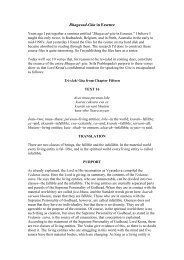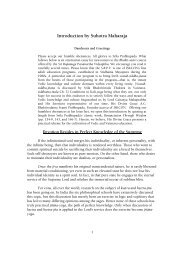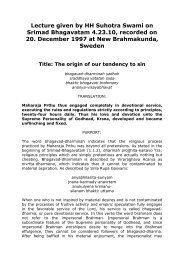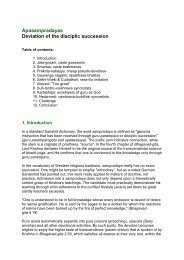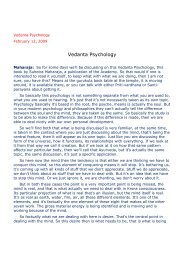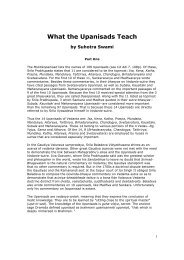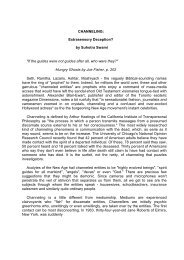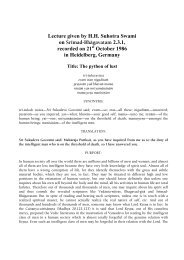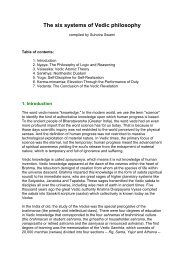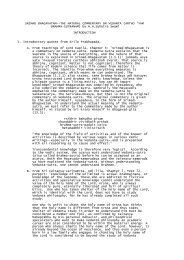Danda 1995 - Suhotra Maharaja Archives
Danda 1995 - Suhotra Maharaja Archives
Danda 1995 - Suhotra Maharaja Archives
- No tags were found...
Create successful ePaper yourself
Turn your PDF publications into a flip-book with our unique Google optimized e-Paper software.
So, I wonder how living entities take birth on this planets. Does it mean thatthere're no women up there?Answer by <strong>Suhotra</strong> SwamiMarch 10, <strong>1995</strong>The Janaloka and Tapaloka planetary systems are said to be the outer regions ofBrahmaloka (i.e. Satyaloka). These regions are attained by perfect sannyasisand brahmacaris in their next lives. Lower than Janaloka and Tapoloka is theMaharloka, which is attained by vanaprasthas. So these places are distinguishedfrom the svargaloka (the planets of the demigods headed by Indra), which issought after by pious people who are interested in sexual pleasure far superiorto that available on earth. The planets of Maharloka and above are called themuniloka (the planets of the munis). Munis are not very inclined to sexualpleasure, but are very inclined to jnana or mental speculation. In other words,the svargaloka is heaven for the karmis, and the muniloka is heaven for thejnanis.There are female personalities in the muniloka. Some of them are demigoddesswho personify and award auspicious qualities desired by the sages, like jnanaand vairagya. Brahma keeps female dancers who perform for his personalworshipable Deity, the Mahapurusa. These dancers are sages (brahmacarinis) whoenchantingly sing the Vedic mantras with perfect intonation and expression. Ifthe residents of the muniloka become interested in sexual enjoyment with oneanother, they have to leave that region and descend to lower levels. Afterfinishing this business, they can return to the muniloka if they didn't getentangled down below. There are Puranic descriptions of some male and femaleresidents of the muniloka getting cursed to take lower births because theybecame involved with each other even while they were living in the muniloka. Sothe situation there is something like that in an ISKCON temple, wherebrahmacaris and brahmacarinis are not supposed to have anything to do with eachother. If they want to get married, they have to live outside of the templebuilding, at least when they wish to conceive a child. Sometimes they getinvolved with each other before marriage, and thus get into trouble.The residents of Maharloka and above are sons and daughters of Brahma, createdasexually from his mind and bodily limbs. Earthly sages who become qualified byausterity and meditation may appear as sons or daughters of Brahma in themuniloka at the beginning of a new kalpa (day of Brahma). There they will livefor at least 4,300,000,000 solar years, which is the life span on Maharloka, thelowest muniloka.MORE ON SATYALOKAComment by <strong>Suhotra</strong> SwamiMarch 11, <strong>1995</strong>In her question, Mataji MMdd did not mention the region of Kailasa (Sivalokawithin this universe), but we should understand that it is also counted as adepartment of Satyaloka. See SB 2.1.28, Purport: even Visnuloka (Svetadvipa,the planet of Ksirodakasayi Visnu) is classified as a Satyaloka.The residents of Kailasa are called ganas. They are devotees of Siva. Some aregreat yogis (like Nandi, Lord Siva's bull), while many are from the category ofghosts and demons. But by the blessings of Siva, they all live in his region ofSatyaloka where they can serve him for the entire duration of this universe. InKailasa, there are both male and female ganas. Because Kailasa is still a placewithin the material world, the ganas are yet influenced by the mode of darkness,and thus they may become subject to sexual desire. As soon as that happens they



